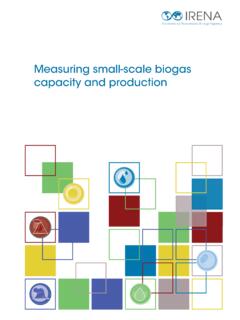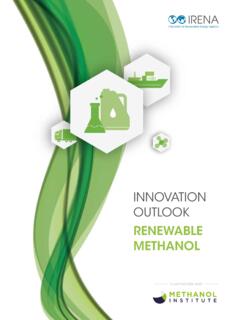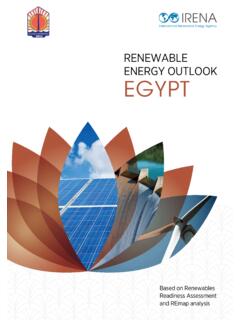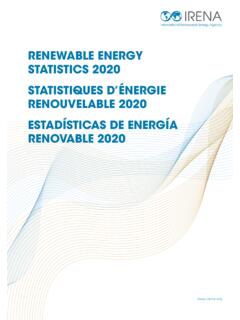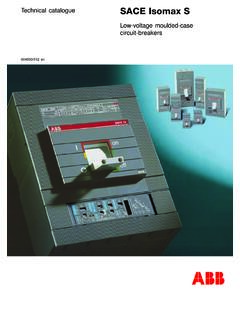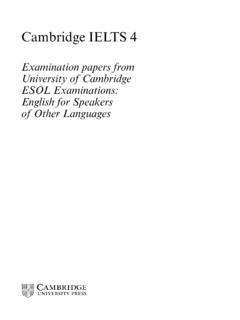Transcription of HYDROGEN FROM RENEWABLE POWER - irena.org
1 HYDROGEN FROM. RENEWABLE POWER . TECHNOLOGY OUTLOOK. FOR THE ENERGY TRANSITION. September 2018. Copyright IRENA 2018. Unless otherwise stated, material in this publication may be freely used, shared, copied, reproduced, printed and/or stored, provided that appropriate acknowledgement is given of IRENA as the source and copyright holder. Material in this publication that is attributed to third parties may be subject to separate terms of use and restrictions, and appropriate permissions from these third parties may need to be secured before any use of such material. ISBN 978-92-9260-077-8. Citation: IRENA (2018), HYDROGEN from RENEWABLE POWER : Technology outlook for the energy transition, International RENEWABLE Energy Agency, Abu Dhabi. About IRENA. The International RENEWABLE Energy Agency (IRENA) is an intergovernmental organisation that supports countries in their transition to a sustainable energy future and serves as the principal platform for international co-operation, a centre of excellence and a repository of policy, technology, resource and financial knowledge on RENEWABLE energy.
2 IRENA promotes the widespread adoption and sustainable use of all forms of RENEWABLE energy, including bioenergy, geothermal, hydropower, ocean, solar and wind energy, in the pursuit of sustainable development, energy access, energy security and low-carbon economic growth and prosperity. Acknowledgements This report benefited greatly from the input of Tim Karlsson of the International Partnership for HYDROGEN and Fuel Cells in the Economy (IPHE) and Bart Biebuyck at the Fuel Cells and HYDROGEN joint undertaking (FCH JU). Valuable comments were also provided by Paul Dodd (University College London, reviewing on behalf of IEA-ETSAP), Josh Eichman (at the US National RENEWABLE Energy Laboratory-NREL), Gerald Linke (German Gas and Water Association- DVGW), Matthew Pellow (Electric POWER Research Institute), Denis Thomas (Hydrogenics) and Raphael Schoentgen. This report received support from a Voluntary Contribution of the Government of Japan to IRENA.
3 Contributing authors: Emanuele Taibi and Raul Miranda (IRENA), Wouter Vanhoudt, Thomas Winkel, Jean-Christophe Lanoix and Frederic Barth (Hinicio). The report is available for download: For further information or to provide feedback: Disclaimer This publication and the material herein are provided as is . All reasonable precautions have been taken by IRENA to verify the reliability of the material in this publication. However, neither IRENA nor any of its officials, agents, data or other third-party content providers provides a warranty of any kind, either expressed or implied, and they accept no responsibility or liability for any consequence of use of the publication or material herein. The information contained herein does not necessarily represent the views of the Members of IRENA. The mention of specific companies or certain projects or products does not imply that they are endorsed or recommended by IRENA in preference to others of a similar nature that are not mentioned.
4 The designations employed and the presentation of material herein do not imply the expression of any opinion on the part of IRENA concerning the legal status of any region, country, territory, city or area or of its authorities, or concerning the delimitation of frontiers or boundaries. Cover image created by IRENA. Images are from iStock unless otherwise indicated. CONTENTS. INSIGHTS FOR POLICY MAKERS 7. 1. SETTING THE SCENE 10. The energy transition: The bigger picture 11. HYDROGEN today 13. HYDROGEN in the energy transition 15. 2. CURRENT TECHNOLOGY STATUS AND DEVELOPMENTS 18. RENEWABLE HYDROGEN production pathways and their current level of maturity 18. HYDROGEN production via electrolysis 19. ALK and PEM electrolysers compared 19. SOEC electrolysers compared to ALK and PEM 23. 3. HYDROGEN APPLICATIONS IN END-USE SECTORS. 31. Decarbonising transport 32. Decarbonising industry 36. Decarbonising the gas grid 38. HYDROGEN -to- POWER based on fuel cells 41.
5 4. CREATING THE HYDROGEN SUPPLY CHAIN 42. 5. RECOMMENDATIONS FOR POLICY MAKERS 45. REFERENCES 48. CONVERSION FACTORS 50. 3. FIGURES. Figure 1: Energy-related carbon dioxide emissions with current policies (Reference Case) compared to accelerated uptake of renewables (REmap), 2010 10. Figure 2: Share of renewables in total final energy consumption under the Reference Case and REmap, and projected RENEWABLE POWER capacity installed in 2050 under 11. Figure 3: Breakdown of global energy-related CO emissions by sector in 12. Figure 4: Global HYDROGEN demand and production 14. Figure 5: Integration of VRE into end uses by means of 16. Figure 6: RENEWABLE HYDROGEN production pathways and current levels of 18. Figure 7: HYDROGEN production and efficiency as a function of the total POWER consumption of a PEM production 21. Figure 8: Electricity price factors in Denmark, 2017 25. Figure 9: Levelised cost of HYDROGEN (LCOH) produced via ALK and PEM in 2017 and as expected in 26.
6 Figure 10: LCOH vs. operating time (HRS for buses).. 27. Figure 11: Cumulative supply chain target costs for HYDROGEN in transport .. 28. Figure 12: Waterfall graph of 2015 LCOH at HRS for buses (full load operation).. 29. Figure 13: Cost of HYDROGEN as a function of cost of electricity and utilisation rate of PEM 29. Figure 14: 2050 potential for HYDROGEN in total final energy supply (all values in EJ).. 32. Figure 15: Segmentation of the transport 33. Figure 16: HYDROGEN tolerance of gas infrastructure 39. Figure 17: Potential future ramp up pattern of the HYDROGEN supply 43. Figure 18: Key challenges and overview of possible enabling measures for 46. 4 H Y DR O GEN FR O M R ENEWABLE POW ER. TABLES. Table 1: Techno-economic characteristics of ALK and PEM. electrolysers (2017, 2025).. 20. Table 2: Dynamic operation of ALK and PEM 23. UNITS OF MEASUREMENT. C degree Celsius EJ exajoule Gt/yr gigatonnes per year GW gigawatt h hour kg kilogram kW kilowatt kWh kilowatt hour MJ megajoule MPa megapascal MW megawatt Nm3 normal cubic metre TWh terawatt hour T E CHN OLOGY B R IE F 5.
7 ABBREVIATIONS. ALK alkaline BEV battery electric vehicle CAPEX capital expenditure CCS carbon capture and storage CCU carbon capture and utilisation COP21 21st Conference of the Parties to UN Framework Convention on Climate Change CO carbon dioxide CSP concentrated solar POWER DRI-H direct reduction via HYDROGEN e-fuel electrofuel FCEV fuel cell electric vehicle FCH JU Fuel Cell HYDROGEN Joint Undertaking FCR frequency containment reserve HHV high heating value HRS HYDROGEN refuelling station H HYDROGEN LDV light-duty vehicle LCOH levelised cost of HYDROGEN LHV lower heating value LOHC liquid organic HYDROGEN carrier OPEX operating expenditure PEM proton exchange membrane PV photovoltaic P2G POWER -to-gas R&D research and development SMR steam-methane reforming SOEC solid oxide electrolyser cell TFEC total final energy consumption VRE variable RENEWABLE energy w/RE with RENEWABLE energy 6 H Y DR O GEN FR O M R ENEWABLE POW ER. INSIGHTS FOR POLICY MAKERS.
8 The global energy system has to undergo sectors (e. g. heat demand in buildings, gas a profound transformation to achieve the turbines in the POWER sector). HYDROGEN targets in the Paris Agreement. In this context, can be combined with carbon dioxide (CO ). low-carbon electricity from renewables may from high-emission industrial processes to become the preferred energy carrier. The share feed up to 100 % syngas into the gas grid. of electricity in all of the energy consumed by end users worldwide would need to increase Transport: Fuel cell electric vehicles to 40 % in 2050 (from about half that amount (FCEVs) provide a low-carbon mobility in 2015) to achieve the decarbonised energy option when the HYDROGEN is produced from world envisaged by the agreement. RENEWABLE energy sources and offer driving performance comparable to conventional However, the total decarbonisation of certain vehicles. FCEVs are complementary to sectors, such as transport, industry and uses battery electric vehicles (BEVs) and can that require high-grade heat, may be difficult overcome some of the current limitations purely by means of electrification.
9 This of batteries (weight, driving range and challenge could be addressed by HYDROGEN refuelling time) in the medium to high duty from renewables, which allows large amounts cycle segments. of RENEWABLE energy to be channelled from the POWER sector into the end-use sectors. HYDROGEN produced from RENEWABLE electricity achieved through an electrolyser HYDROGEN could therefore be the missing link could facilitate the integration of high levels in the energy transition: RENEWABLE electricity of variable RENEWABLE energy (VRE) into the can be used to produce HYDROGEN , which can energy system. in turn provide energy to sectors otherwise difficult to decarbonise through electrification. An electrolyser is a device that splits water into HYDROGEN and oxygen using electricity. These include the following: When electricity produced from RENEWABLE energy sources is used, the HYDROGEN Industry: HYDROGEN is widely used in several becomes a carrier of RENEWABLE energy, industry sectors (refineries, ammonia complementary to electricity.)
10 Electrolysers production, bulk chemicals, etc.), with the can help integrate VRE into POWER systems, vast majority of it being produced from as their electricity consumption can be natural gas (see Figure 4). HYDROGEN from adjusted to follow wind and solar POWER renewables could replace fossil fuel-based generation, where HYDROGEN becomes a feedstocks in high-emission applications. source of storage for RENEWABLE electricity. Thus, they offer a flexible load and can also Buildings and POWER : HYDROGEN from provide grid balancing services (upwards RENEWABLE sources can be injected into and downwards frequency regulation). existing natural gas grids up to a certain whilst operating at optimal capacity to meet share, thereby reducing natural gas demand for HYDROGEN from industry and the consumption and emissions in end-use transport sector or for gas grid injection. T E CHN OLOGY B R IE F 7. The built-in storage capacity of downstream equipment manufacturers for vehicles, and sectors (e.
